Thursday Jan 08, 2026
Thursday Jan 08, 2026
Friday, 22 September 2023 00:45 - - {{hitsCtrl.values.hits}}
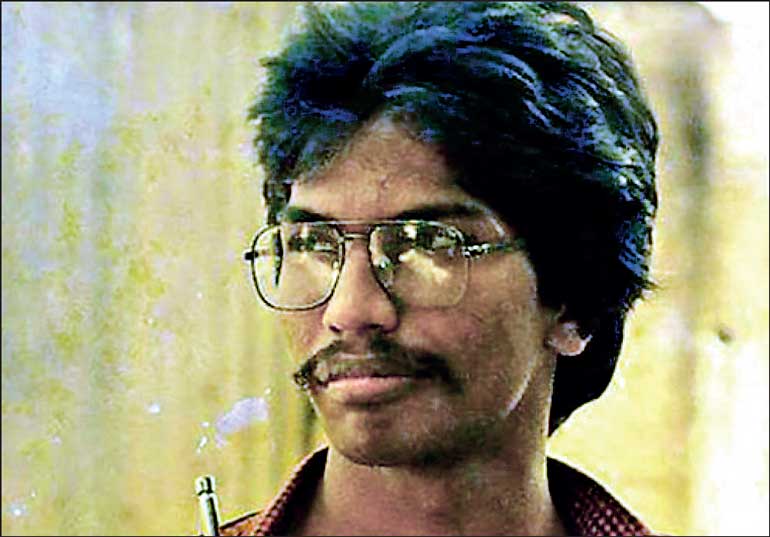
Rasiah Parthiban alias Thileepan
 The 26th of September has become an important day in Sri Lanka ever since the then Prime Minister Solomon West Ridgeway Dias Bandaranaike (SWRDB) was assassinated in 1959. Bandaranaike who was shot by Talduwa Somarama Thera on 25 September, succumbed to his injuries the following day. September 26th however is of particular significance to a substantial number of Sri Lankan Tamils also. For it was on this day in 1987 that a senior member of the Liberation Tigers of Tamil Eelam (LTTE) Thileepan died in Nallu after undertaking a fast unto death.
The 26th of September has become an important day in Sri Lanka ever since the then Prime Minister Solomon West Ridgeway Dias Bandaranaike (SWRDB) was assassinated in 1959. Bandaranaike who was shot by Talduwa Somarama Thera on 25 September, succumbed to his injuries the following day. September 26th however is of particular significance to a substantial number of Sri Lankan Tamils also. For it was on this day in 1987 that a senior member of the Liberation Tigers of Tamil Eelam (LTTE) Thileepan died in Nallu after undertaking a fast unto death.
Although the Tigers have lost thousands of cadres during the many years it waged war against the Sri Lankan State, the death of Thileepan was entirely different from the deaths of other LTTE fighters. Thileepan’s demise was not due to direct violence but due to non-violent direct action. He engaged in a fast unto death protest on 15 September 1987 and died after 12 days of fasting without even drinking water. This was after the Indo-Lanka accord of 29 July 1987. The Indian army referred to as the Indian Peace Keeping Force (IPKF) was stationed in Jaffna then.
Thileepan’s fast and death has been etched into the collective memory of Tamils over the years. His death is commemorated on a wide scale every year. The period between 15 September and 26 September is marked with acts of memorialisation in many parts of Northern and Eastern Sri Lanka and also in many countries where there are substantial concentrations of Tamils.
Thileepan’s 36th death anniversary falls next week on 26 September 2023. It is against this backdrop that this column focuses on the LTTE “martyr” Thileepan in this two-part article. The first part will be about Thileepan the person and his role in the LTTE. The second will be on his death – fast and its aftermath.
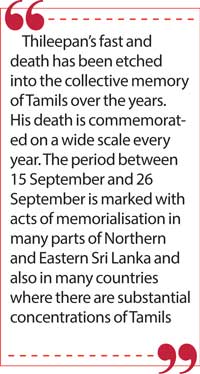 Rasiah Parthiban
Rasiah Parthiban
Thileepan whose name was Rasiah Parthiban was born on 29 November 1964. His father Rasiah “Master” was a respected school teacher. Parthiban was the youngest of four children all boys. He lost his mother while an infant and was brought up by his father. The family hailed from Urelu a village about eight miles from Jaffna town in the Valigamam sector of the Jaffna peninsula.
Though Thileepan’s given name was Parthipan there is a mistaken impression that his real name was Amirthalingam. This is not correct. This mistake however arose due to many LTTE members themselves addressing Thileepan at times as Amirthalingam. Thus he was popularly referred to as Amirthalingam. Why was Thileepan called Amirthalingam?
This was because Thileepan was in charge of the LTTE’s political wing in Jaffna for a long time. He was the Tiger political commissar for many years. Thus he was jocularly regarded as a “politician” and not a guerrilla by fellow Tigers. Since former Leader of the opposition and Tamil United Liberation Front (TULF) Secretary-General Appappillai Amirthalingam was the most important and well-known Tamil political figure at that time, Thileepan was also nicknamed Amirthalingam. It was a name that stuck.
Rasiah Parthipan alias Thileepan was a student at the well-known northern educational institution Jaffna Hindu College. During his school days he was the Jaffna district champion in chess and participated in all-island competitions. He sat for his G.C.E. A/L and obtained very good results that qualified him for admission to the medical faculty in 1983. Rasiah Parthiban did not enter university. Instead he entered the world of armed Tamil militancy by joining the LTTE.
 Ravindran alias Pandithar
Ravindran alias Pandithar
Initially he was recruited as a helper. Later he began assisting Ravindran alias Pandithar in recruitment. Thileepan did not receive any military training in North or South India. He received arms training locally in Jaffna. In those days former Jaffna LTTE commander Pandithar was in overall charge of both the military and political wings. Sathasivampillai Krishnakumar alias Kittu and Rasiah Parthiban alias Thileepan were placed second-in-command of the military and political wings respectively by Pandithar.
After Pandithar’s death in 1985 Kittu became Jaffna commander. Thileepan was placed in charge of the political section. He was given a comparatively free hand by Kittu. Soon Thileepan became a well-known figure in Jaffna. He interacted well with people and had a flair for public relations.
Promoted as LT. Colonel
LTTE supremo Prabhakaran who returned to Jaffna from India in January 1987 was greatly impressed by Thileepan’s ability and dedication. The LTTE leader promoted Thileepan as Lt. Colonel, a rank reserved only for district commanders in the LTTE hierarchy earlier.
Prabhakaran also appointed Thileepan in charge of all the LTTE political offices in the entire north-east. Thileepan’s headquarters was at Potpathy road in Kokuvil. After the first “Black Tiger” Capt. Miller’s death at Nelliaddi on 5 July 1987, the political headquarters was named “Miller Office”. A few months later, Thileepan himself like Miller was to court death voluntarily in September.
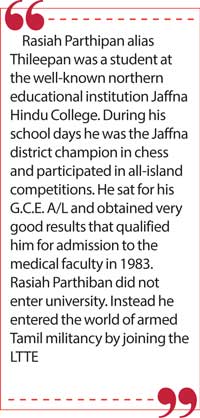 Although Thileepan was in charge of the political wing for a lengthy period of time, he was not a person who avoided actual combat. It was Kittu’s contention that there should not be a strict divide between the fighters and the political activists. Kittu felt that it would result in unwanted jealousies among the cadres and also nurture an unhealthy tradition where the fighter cadre would be “mutts” and political cadres “cowards”. Thus Thileepan actively participated in many military operations and was injured several times.
Although Thileepan was in charge of the political wing for a lengthy period of time, he was not a person who avoided actual combat. It was Kittu’s contention that there should not be a strict divide between the fighters and the political activists. Kittu felt that it would result in unwanted jealousies among the cadres and also nurture an unhealthy tradition where the fighter cadre would be “mutts” and political cadres “cowards”. Thus Thileepan actively participated in many military operations and was injured several times.
Once in Anaikottai the army stopped his motorcycle. The unarmed Thileepan lashed out at the soldiers with his bag and ran away. The soldiers fired and injured his arm. While scrambling through a fence, he lost his verti. Thileepan identified himself to an Anaaikottai resident and borrowed a “salvai” (shawl) from him and strapped it around his waist. Even as he was running away the strap on his rubber slipper gave way and he discarded it.
Thileepan got away with an injury on his arm. About a year later Thileepan held a political meeting at Anaikotai. After the meeting was over, an old woman came up to him and gave him a bag. It was the old rubber slipper with the ruptured strap carefully stitched back by the woman who had preserved it for nearly a year. Such was the esteem Thileepan had among the people then.
Thileepan also received wounds on his back in a skirmish outside the Jaffna fort. He was injured a third time in an operation in Thondamanaru. He received serious injuries on his stomach. Later seven inches of his intestines had to be removed.
The Tiger political commissar also had a brush with death when the vehicle he was driving was fired upon by a helicopter. Although the vehicle was riddled extensively Thileepan escaped without a scratch in typical Chuck Norris fashion.
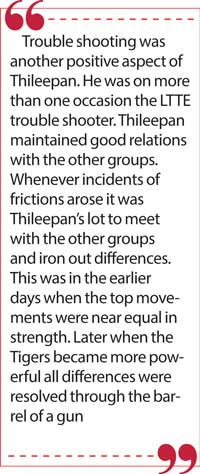 Political chief of Jaffna
Political chief of Jaffna
During Thileepan’s tenure as political chief of Jaffna he adopted new methods with the consent and concurrence of Kittu. The Jaffna peninsula was sub-divided by Thileepan into 23 political divisions with each division headed by a political commissar. All the political commissars would meet every Sunday at different locations under Thileepan’s Chairmanship. Reviews and reports were presented and all issues would be thrashed out in detail.
Another feature adopted by Thileepan was the introduction of a system whereby the people could convey their complaints to the LTTE through complaint boxes installed in various parts of the peninsula. People with grievances could write them and toss them into the boxes. Even anonymous complaints were entertained.
The people of Jaffna availed themselves of this opportunity and submitted complaints about LTTE cadres too. Disciplinary inquiries were initiated and consequent action was taken against LTTE cadres as a result of these complaints. This was the first time that the LTTE submitted itself to a partial degree of accountability to the people at least.
The LTTE political chief also travelled extensively throughout the peninsula and staged mass meetings and group discussions. He spoke fluent Tamil in a colloquial jargon without rhetorical flourishes. He also had a sense of humour and quickly related to people.
 Once at Neervely the residents held a rally in protest against the thefts in the area. They set up road blocks and prevented traffic. All the Tamil militant movements sent their representatives. While all the other groups denied involvement in the robberies, Thileepan won the people over by saying, “I am not going to lie to you because you all know who is responsible.” Neervely became an LTTE bastion after Thileepan’s speech.
Once at Neervely the residents held a rally in protest against the thefts in the area. They set up road blocks and prevented traffic. All the Tamil militant movements sent their representatives. While all the other groups denied involvement in the robberies, Thileepan won the people over by saying, “I am not going to lie to you because you all know who is responsible.” Neervely became an LTTE bastion after Thileepan’s speech.
LTTE publication “Kalaththil”
Thileepan also edited the LTTE publication “Kalaththil” (in the field). He also started a journal “Suthanthirap Paravaigal” (birds of freedom) for the LTTE women cadres. It was edited by the woman fighters. Thileepan was a powerful and prolific writer. He also played a prominent role in the affairs of the LTTE Radio and Television network in Jaffna.
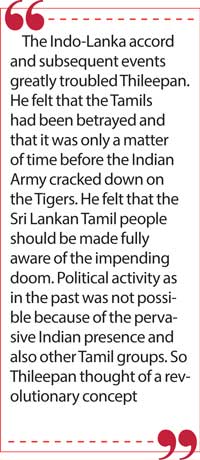 Trouble shooting was another positive aspect of Thileepan. He was on more than one occasion the LTTE trouble shooter. Thileepan maintained good relations with the other groups. Whenever incidents of frictions arose it was Thileepan’s lot to meet with the other groups and iron out differences. This was in the earlier days when the top movements were near equal in strength. Later when the Tigers became more powerful all differences were resolved through the barrel of a gun.
Trouble shooting was another positive aspect of Thileepan. He was on more than one occasion the LTTE trouble shooter. Thileepan maintained good relations with the other groups. Whenever incidents of frictions arose it was Thileepan’s lot to meet with the other groups and iron out differences. This was in the earlier days when the top movements were near equal in strength. Later when the Tigers became more powerful all differences were resolved through the barrel of a gun.
Thileepan also participated in important political discussions. He was a key member of LTTE delegations led by Kittu participating in talks with different people such as SLMP leader Vijaya Kumaratunga, Yatiyantota UNP Parliamentarian Vincent Perera, Lt. Col. Jayantha Kotelawela and members of the Buddhist clergy.
When LTTE supremo Prabhakaran was taken by helicopter to India for talks with the then Indian Prime Minister Rajiv Gandhi prior to the Indo-Lanka accord, Thileepan also accompanied the Tiger leader. Later Prabhakaran and others including Thileepan went by an Indian Air Force plane from Madras to New Delhi.
Thileepan under the guidance of Kittu was also responsible for setting up a political party for the LTTE named People’s Front of Tamil Eelam. This was in 1986. Twisted information passed by LTTE stalwart “Basheer Kaka” along with unfair criticism levelled by Anton Balasingham led Prabhakaran to view the exercise with suspicion. Kittu was ordered to abandon the project and Thileepan was summoned to Madras for questioning.
 Thileepan could not go to Madras then as ordered because he fell ill and was later injured in combat. In 1989 the same People’s Front political project planned by Thileepan in 1986 was formally adopted by Prabhakaran after talks with the Government headed by President Ranasinghe Premadasa. The LTTE registered a political party named “People’s Front of Tamil Eelam” (PFLT) with Mahendrarajah alias “Mahathaya” as President and Narendran alias Yogi as Secretary.
Thileepan could not go to Madras then as ordered because he fell ill and was later injured in combat. In 1989 the same People’s Front political project planned by Thileepan in 1986 was formally adopted by Prabhakaran after talks with the Government headed by President Ranasinghe Premadasa. The LTTE registered a political party named “People’s Front of Tamil Eelam” (PFLT) with Mahendrarajah alias “Mahathaya” as President and Narendran alias Yogi as Secretary.
“Reverse gear” motor cycle
Despite his remarkable political acumen, Thileepan was incredibly naive in mundane matters. He was the target of many a leg-pull. One story is about how Thileepan was told that another Tiger Ravi’s motorcycle had been equipped with “reverse gear”. Little realising it was a joke, Thileepan had remonstrated with Kittu that his motorcycle too should have the same.
Incidentally Thileepan’s motorcycle was perhaps the worst maintained within the LTTE. Kittu who was a stickler for proper vehicle maintenance tolerated laxity in this regard only from Thileepan.
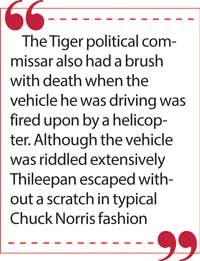 The Indo-Lanka accord and subsequent events greatly troubled Thileepan. He felt that the Tamils had been betrayed and that it was only a matter of time before the Indian Army cracked down on the Tigers. He felt that the Sri Lankan Tamil people should be made fully aware of the impending doom. Political activity as in the past was not possible because of the pervasive Indian presence and also other Tamil groups. So Thileepan thought of a revolutionary concept.
The Indo-Lanka accord and subsequent events greatly troubled Thileepan. He felt that the Tamils had been betrayed and that it was only a matter of time before the Indian Army cracked down on the Tigers. He felt that the Sri Lankan Tamil people should be made fully aware of the impending doom. Political activity as in the past was not possible because of the pervasive Indian presence and also other Tamil groups. So Thileepan thought of a revolutionary concept.
Non-violent action
Thileepan knew that a violent response to India was to invite disaster as the Tamil people themselves would not be in favour of it. So he decided to adopt a non-violent course of action against India. What happened next will be related in detail in the second part of this article.
(The writer can be reached at [email protected].)